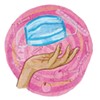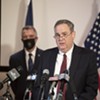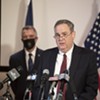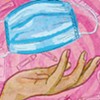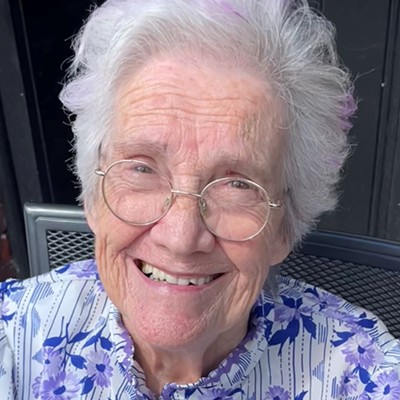Switch to the mobile version of this page.
Vermont's Independent Voice
- News
- Arts+Culture
- Home+Design
- Food
- Cannabis
- Music
- On Screen
- Events
- Jobs
- Obituaries
- Classifieds
- Personals
Browse News
Departments
Browse Arts + Culture
View All
local resources
Browse Food + Drink
View All
Browse Cannabis
View All
-
Culture

'Cannasations' Podcaster Kris Brown Aims to 'Humanize'…
-
True 802

A Burlington Cannabis Shop Plans to Host…
-
Business

Judge Tosses Burlington Cannabiz Owner's Lawsuit
-
Health + Fitness

Vermont's Cannabis Nurse Hotline Answers Health Questions…
-
Business

Waterbury Couple Buy Rare Vermont Cannabis License
Browse Music
View All
Browse On Screen
Browse Events
View All
Quick Links
Browse Classifieds
Browse Personals
-

If you're looking for "I Spys," dating or LTRs, this is your scene.
View Profiles
Special Reports
Pubs+More
Thursday, January 6, 2022
Education / Health Schools Contend With Omicron Surge During First Week Back
Posted By Alison Novak on Thu, Jan 6, 2022 at 6:43 PM
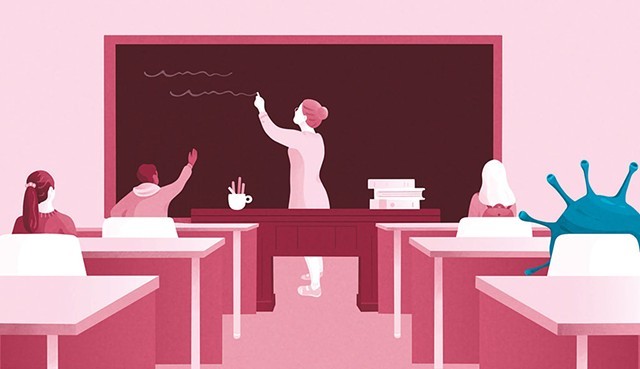
- File: Diana Bolton
As cases of COVID-19 fueled by the Omicron variant continue to surge, U.S. Secretary of Education Miguel Cardona on Wednesday highlighted Vermont as a national model for managing the wave.
Citing the high number of school-age Vermonters vaccinated against COVID-19, Cardona tweeted that "getting vaccinated & boosted is the best way to keep our classrooms safe and schools open year-round." He again praised the state in an interview with National Public Radio.
But educators in those Vermont schools have painted a far less rosy picture. The return to class has coincided with the huge spike in cases and with changing, complicated guidance from the U.S. Centers for Disease Control and Prevention.
Just a few days into the new year, with COVID-19 cases in the state hitting a record high on Thursday, some schools were forced to close because of high numbers of cases or staff shortages. Administrators appealed to parents to help keep schools safe by getting their children vaccinated and keeping students home if they displayed virus symptoms. And some districts had to pause contact tracing and "Test to Stay" programs — which allow close contacts to stay in school with a negative rapid antigen test — due to a lack of resources.
The state attempted to head off the chaos. Over the holiday break, officials set up 51 sites to distribute rapid antigen tests to families. Each K-12 student was eligible for a kit with two tests, which they were advised to use prior to returning to the classroom. Approximately 44,700 kits were given out, though 87,000 were available, according to Vermont Department of Health spokesperson Ben Truman. State agencies were working on distributing the remainder to schools to use at their discretion, Truman said.
Yet school closures — and cases — are already piling up. In a letter to families Wednesday night, the Winooski School District announced it would close on Thursday and Friday due to an onslaught of cases. Since Monday, the letter said, 35 people in the school community had tested positive for COVID-19. Twenty of them were infectious while in school, leading to "an extensive list" of close contacts.
The district said that it wasn't able to contact everyone who had been exposed to the virus while in school, and advised people to monitor members of their household for symptoms. Remote learning wasn't available. Instead, Winooski students will make up the missed days at the end of the school year, the letter said.
In Orleans County — where just 32 percent of 5- to 11-year-olds and 59 percent of 12- to 17-year-olds have received at least one COVID-19 vaccine dose — North Country Union Junior High School went remote on Wednesday and will remain closed through the end of the week due to staffing shortages.
"I would not be surprised if we saw more schools go remote by next week," North Country Supervisory Union superintendent John Castle wrote in an email to Seven Days. Though the district was only experiencing a slight uptick in cases, he said, "I suspect we are just starting to see the Omicron surge and will have more cases to contend with next week."
Irasburg Village School, a K-8 school in Orleans County, also closed on Wednesday through the end of the week due to staff absences. The Vermont Agency of Education didn't immediately respond to a question from Seven Days about other schools that had closed.
"We continue to do our best to keep students in school but it is especially challenging at the high school right now," Olsen-Farrell wrote. "Please anticipate that there could be school cancellations in the coming days."
In the Barre Unified Union School District, "an incredibly high number of students" had arrived at the district's three schools this week with "obvious" COVID-19 symptoms and had to be sent home, superintendent Chris Hennessey wrote in an email to parents on Wednesday. In some cases, Hennessey wrote, students had come to school even after testing positive for the virus.
Irasburg Village School, a K-8 school in Orleans County, also closed on Wednesday through the end of the week due to staff absences. The Vermont Agency of Education didn't immediately respond to a question from Seven Days about other schools that had closed.
click to enlarge 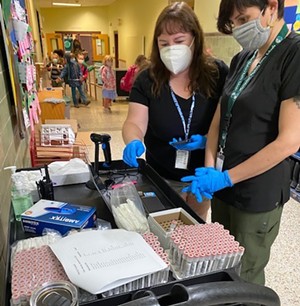
At Slate Valley Unified School District in Fair Haven, superintendent Brooke Olsen-Farrell wrote to staff and families on Wednesday encouraging those 12 and up to get vaxxed or boosted on Saturday at a walk-up clinic outside Fair Haven Union High School. This week, the feds cleared booster shots for 12- to 15-year-olds who are five months out from their initial shots.
- Courtesy of Montpelier Roxbury Schools
- Union Elementary School nurses administer tests in Montpelier
"We continue to do our best to keep students in school but it is especially challenging at the high school right now," Olsen-Farrell wrote. "Please anticipate that there could be school cancellations in the coming days."
In a follow-up email to Seven Days, Olsen-Farrell said that her district was forced to stop contact tracing after it identified 51 COVID-19 cases among students and staff this week. Thirty staff members were absent because they had the virus or were a close contact, she said.
And in Rutland City Public Schools, the district this week had 100 student cases and 25 staff cases, superintendent Bill Olson said. Adam Bunting, principal of Champlain Valley Union High School in Hinesburg, said there were 29 positive cases as of Wednesday, though most weren't infectious while on campus. On Thursday, Bunting said there were four more positive cases. CVU has a student vaccination rate of around 92 percent.
And in Rutland City Public Schools, the district this week had 100 student cases and 25 staff cases, superintendent Bill Olson said. Adam Bunting, principal of Champlain Valley Union High School in Hinesburg, said there were 29 positive cases as of Wednesday, though most weren't infectious while on campus. On Thursday, Bunting said there were four more positive cases. CVU has a student vaccination rate of around 92 percent.
Hennessey said in an interview that the vast majority of students and families in his district were trying to follow COVID-19 protocols — but some were flouting them. He attributed the behavior to pandemic exhaustion: Parents are worried about missing yet another day of work or having their kids miss more school. Some have expressed anger, frustration and sadness when principals or school nurses call them to pick up their children from school because of virus symptoms.
From the start of school until the holiday break, Barre schools had more than 300 cases that required contact tracing, Hennessey said. This week, the district has been unable to tally the number of positives.
Hennessey said he would meet with his administrative team about pausing contact tracing because of the immense time and effort it requires. That would mean all students, even close contacts of positive cases, could come to school, as long as they didn't have COVID-19 symptoms.
 Hennessey said he would appreciate clear, detailed guidance from the Vermont Department of Health and Agency of Education about virus mitigation amid the Omicron surge. School districts "are all on our own," he said.
Hennessey said he would appreciate clear, detailed guidance from the Vermont Department of Health and Agency of Education about virus mitigation amid the Omicron surge. School districts "are all on our own," he said.
The U.S. Centers for Disease Control and Prevention has changed its guidance on isolation, making it difficult for schools to know what to do this week, Hennessey said.
The state is mostly adhering to CDC guidance, which requires those who test positive for COVID-19 to stay home and isolate for at least five days. According to the CDC, someone can end quarantine after day five if they are asymptomatic or their symptoms have improved, but must wear a mask around others through day 10.
Vermont, though, wants residents to test negative twice before ending quarantine on day five. That guidance is waived if you meet all requirements — but are unable to get a test.
From the start of school until the holiday break, Barre schools had more than 300 cases that required contact tracing, Hennessey said. This week, the district has been unable to tally the number of positives.
Hennessey said he would meet with his administrative team about pausing contact tracing because of the immense time and effort it requires. That would mean all students, even close contacts of positive cases, could come to school, as long as they didn't have COVID-19 symptoms.
Related School Administrators Say They Can’t Manage State’s New COVID-19 Testing Proposal

School Administrators Say They Can’t Manage State’s New COVID-19 Testing Proposal
By Alison Novak
Education
The U.S. Centers for Disease Control and Prevention has changed its guidance on isolation, making it difficult for schools to know what to do this week, Hennessey said.
The state is mostly adhering to CDC guidance, which requires those who test positive for COVID-19 to stay home and isolate for at least five days. According to the CDC, someone can end quarantine after day five if they are asymptomatic or their symptoms have improved, but must wear a mask around others through day 10.
Vermont, though, wants residents to test negative twice before ending quarantine on day five. That guidance is waived if you meet all requirements — but are unable to get a test.
Montpelier Roxbury Public Schools tested all asymptomatic students who had family permission at the beginning of the week and found 12 positive cases, superintendent Libby Bonesteel said. Many students were also home sick.
Montpelier Roxbury typically participates in "Test to Stay." But on Thursday, none of the district's four schools had enough rapid tests to run the program.
The district requested more tests from the state on Monday morning, but Bonesteel wasn't sure when they would arrive.
Montpelier Roxbury typically participates in "Test to Stay." But on Thursday, none of the district's four schools had enough rapid tests to run the program.
The district requested more tests from the state on Monday morning, but Bonesteel wasn't sure when they would arrive.
Tags: COVID-19, Vermont Agency of Education, Department of Health, Omicron, surge, cases, virus, schools, Test to Stay, Web Only, Image
Comments
Comments are closed.
Since 2014, Seven Days has allowed readers to comment on all stories posted on our website. While we’ve appreciated the suggestions and insights, the time has come to shut them down — at least temporarily.
While we champion free speech, facts are a matter of life and death during the coronavirus pandemic, and right now Seven Days is prioritizing the production of responsible journalism over moderating online debates between readers.
To criticize, correct or praise our reporting, please send us a letter to the editor. Or send us a tip. We’ll check it out and report the results.
Online comments may return when we have better tech tools for managing them. Thanks for reading.
Related Stories
About The Author

Alison Novak
Bio:
Alison is the former managing editor at Kids VT, Seven Days' parenting publication and writes about education for Seven Days.
Alison is the former managing editor at Kids VT, Seven Days' parenting publication and writes about education for Seven Days.
































